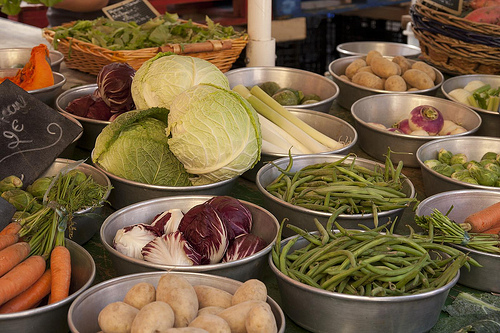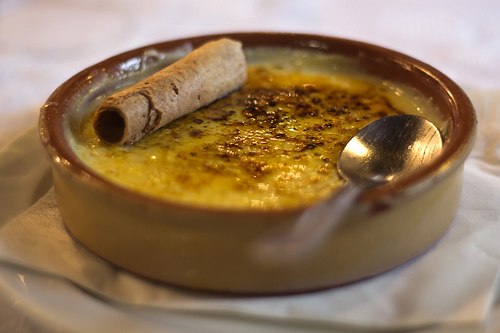Disclosure: In any review for a product or service, products or compensation may have been provided to me to help facilitate my review. All opinions are my own and honest. I am disclosing this in accordance with FTC Guidelines. Please see “Disclose” and "Terms of Use" tabs for more information.
One of the things people look forward to when visiting the South of France is sampling some of the area’s gorgeous cuisine, which is known the world over for its Mediterranean flavors and sophisticated French ‘Je ne sais quoi’. Depending on which area you’re headed for, there are regional specialties and ‘must tastes’ which will make your trip all the more delicious.
If you spend any amount of time in the absolute South of France, namely the regions of Languedoc-Roussillon and Provence-Alpes-Cote d’Azur, you’ll certainly taste the Basque and Spanish influences, with juicy tomatoes, spicy sausages and peppers all very much in evidence. Aromatic herbs, olive oil and colorful fruit and vegetables make the cuisine typically Mediterranean and absolutely delicious.
Languedoc-Roussillon is chilled out and relaxed, with a sunny climate and plenty of beaches. You can explore quaint coastal towns and ports, find Roman and Greek historical monuments and ruins and medieval castles, all dotted around picturesque towns like Montpellier, Perpignan, Nîmes, and Carcassonne. Traveling through this region offers you a truly European tour, both in terms of culture and cuisine.
Provence-Alpes-Cote d’Azur is the place to go for beaches combined with culture; the Alps, wetlands and vineyards also help make up a landscape that also features hilltop towns, medieval villages and fashionable areas populated with art galleries and music festivals.
Provence-Alpes-Cote d’Azur (Provence)
Being so close to Italy, Provence can’t help but be heavily influenced by its neighbor. You’ll find some of the most beautiful villages in France here, especially as you venture further inland.
- Head to L’Art Glacier in Ansois if you’re an ice cream aficionado – this ice cream parlor at the foot of the Luberon Hills has over 60 flavors, including lavender, gingerbread and even Lily of the valley.
- Being the seafood capital of France means that Marseilles, also France’s oldest city, offers the discerning traveler some amazing fish dishes. Try the bouillabaisse in any of its varieties; Bouillabaisse du Ravi, which traditionally contains six different types of fish, or Bouillabaisse du Pêcheur, which is lighter with just three. If you enjoy a garlicky fish stew you could also try Bourride. Another fishy specialty is Brandade de Morue, which originally comes from Nimes – a delicious puree of salt cod, cream, garlic, olive oil and potatoes, which is often served in restaurants as a starter.
- Venice is a real foodie mecca, choc-full of patisseries to satisfy any sweet tooth and restaurants to die for. Just 20 miles inland from Nice airport, La Terrasse du Clemenceau is popular with locals and serves a delicious Salade au Chevre Chaud, or goat’s cheese salad, as well as fresh pizzas best enjoyed on the terrace outside. The rabbit, or ‘lapin’ is also highly recommended by previous diners.
- Le Passage is a cosmopolitan eatery, set in a sympathetically and very tastefully renovated factory building in downtown Aix en Provence. You can sample dishes from three different kitchens – one traditionally French, the O-Zen Buffet World/Fusion kitchen and the Thai restaurant upstairs. Aix en Provence is also where you’ll find the beautiful Cours Mirabeau, described as ‘Europe’s most captivating street’. Cours Mirabeu is certainly incredibly pretty – a street canopied by trees, sprinkled with Baroque fountains, and lined with pretty cafes such as Café des Deux Garçons, previously frequented by French artist Cézanne.
Don’t like fish? Try the Camargue lamb, which gets its distinctive flavour from grazing on the salt marsh grasses of the Camargue. Ask for Gardiane d’agneau.
Vegetarians are catered for well in the South, with Ratatouille – the French version of which contains aubergine, peppers and herbs stewed in olive oil – and Pistou, a basil, garlic and olive oil sauce used to add flavor to soups. Fancy a pizza? Go for the Pissaladiere, the French version of Pizza Napolitana, which has less cheese and more onion than its Italian cousin.
- If you have a sweet tooth, hunt down a native version of the classic tarte au citron, a sweet pastry tart filled with lemon cream. Venture towards the Italian border and you’ll find Menton, between Monaco and the Italian Riviera, which is famous for its lemons and a really delicious example of tarte au citron. While you’re there, check out the Artisanal Jam Factory, which specializes in flavours you won’t find in the UK, such as lemon and thyme, fig, melon and tomato.
Languedoc-Roussillon
Languedoc is the place to go for long, flat, sandy beaches and resorts. If you tire of lazing on a beach, you could head inland and explore the city of Montpellier, Nimes, or Narbonne.
Nimes has plenty to offer, including a Roman temple from the 4th Century BC and a Roman amphitheatre that was used as a setting for the film Gladiator. Nimes is small – easy to explore on foot, and you can see most of it in a day.
- In Nimes, you can also investigate the Michelin starred L’Atelier Jean-Luc Rabanel for a healthy but utterly delicious experience. The experimental chef concocts French and Mediterranean style dishes, and if you really want to push the boat out and test your stomach to the limits, there’s a nine course meal with wine or a sixteen-course tasting menu to tempt you.
There’s plenty of traditional French food to enjoy in Languedoc-Roussillon. Cassoulet is one of the most famous dishes of this region, and if you travel here in the winter you’ll find it everywhere in the towns and villages of the South. Most of the local French restaurants serve a version of this dish – although more likely as a soup than a casserole, and it’s a hearty dish, packed with haricot beans, pork and duck in a thick tomato sauce.
For dessert, try the Crème Catalane, a regional variation on Crème Brulee that replaces the vanilla in the custard with orange or lemon zest and cinnamon.
The South West – Aquitaine and Midi-Pyrenees
The South-western corner of France, on the border with Spain, is well known for popular resorts such as Biarritz and for the western Pyrenean Mountains. You’ll find the famous vineyards of Bordeaux here, along with sandy beaches, flat lands and, in the far South West, quite a bit of seafront development.
The area around the Pyrenees National Park is rich in fruit, especially peaches, apricots and stoned fruits, as well as being famous for meats and sausages, including world-renowned Bayonne ham. Travel to Toulouse for delicious sausages made with pork, smoked bacon, wine and garlic, as well as France’s famous Roquefort cheese – a blue cheese made from ewe’s milk.
- For an elegant restaurant with a view, L’Amphityron is perfect. You’ll find it in Colomiers, situated on the edge of a forest and overlooking Toulouse’s pretty pink buildings. The chef is well known for idiosyncratic dishes, especially poultry – and according to reviewers, the free range duck is a particularly delicious specialty.
One of the local specialties of the Dordogne area of France is its world famous Perigord truffles. If you can’t stretch to truffles, you could always try the local goat’s cheese, which is usually served grilled (chevre tiede) and with a salad. If you’re a fan, hunt down the preserved goat’s cheese flavoured with herbs too.
Something to drink…
Languedoc-Roussillon and Provence-Alpes-Cote d’Azur obviously can’t compete with Bordeaux in the South West when it comes to wine, but the wines from both regions can be utterly delicious. If you’re in St Tropez try the local rosé, Estandon and if red is your favorite tipple, Bandol is a good quality red. Lovers of dessert wines will enjoy the Muscadet de Cassis. For an aperitif, try the Pastis – a locally produced spirit made with anise.



















Speak Your Mind
You must be logged in to post a comment.